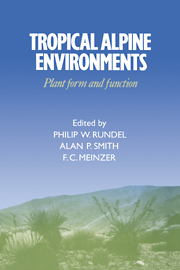Book contents
- Frontmatter
- Contents
- List of contributors
- Preface
- 1 Introduction to tropical alpine vegetation
- 2 Tropical alpine climates
- 3 Páramo microclimate and leaf thermal balance of Andean giant rosette plants
- 4 Comparative water relations of tropical alpine plants
- 5 Cold tolerance in tropical alpine plants
- 6 Anatomy of tropical alpine plants
- 7 Environmental biology of a tropical treeline species, Polylepis sericea
- 8 Morphological and physiological radiation in páramo Draba
- 9 Sediment-based carbon nutrition in tropical alpine Isoetes
- 10 Functional significance of inflorescence pubescence in tropical alpine species of Puya
- 11 Turnover and conservation of nutrients in the pachycaul Senecio keniodendron
- 12 Soil nutrient dynamics in East African alpine ecosystems
- 13 An overview of the reproductive biology of Espeletia (Asteraceae) in the Venezuelan Andes
- 14 Population biology of Mount Kenya lobelias
- 15 Population biology of Senecio keniodendron (Asteraceae), an Afroalpine giant rosette plant
- 16 Population dynamics and flowering in a Hawaiian alpine rosette plant, Argyroxiphium sandwicense
- 17 Plant form and function in alpine New Guinea
- 18 Alpine herbivory on Mount Kenya
- 19 Biotic interactions in Hawaiian high elevation ecosystems
- 20 Tropical alpine ecology: progress and priorities
- Index
16 - Population dynamics and flowering in a Hawaiian alpine rosette plant, Argyroxiphium sandwicense
Published online by Cambridge University Press: 21 October 2009
- Frontmatter
- Contents
- List of contributors
- Preface
- 1 Introduction to tropical alpine vegetation
- 2 Tropical alpine climates
- 3 Páramo microclimate and leaf thermal balance of Andean giant rosette plants
- 4 Comparative water relations of tropical alpine plants
- 5 Cold tolerance in tropical alpine plants
- 6 Anatomy of tropical alpine plants
- 7 Environmental biology of a tropical treeline species, Polylepis sericea
- 8 Morphological and physiological radiation in páramo Draba
- 9 Sediment-based carbon nutrition in tropical alpine Isoetes
- 10 Functional significance of inflorescence pubescence in tropical alpine species of Puya
- 11 Turnover and conservation of nutrients in the pachycaul Senecio keniodendron
- 12 Soil nutrient dynamics in East African alpine ecosystems
- 13 An overview of the reproductive biology of Espeletia (Asteraceae) in the Venezuelan Andes
- 14 Population biology of Mount Kenya lobelias
- 15 Population biology of Senecio keniodendron (Asteraceae), an Afroalpine giant rosette plant
- 16 Population dynamics and flowering in a Hawaiian alpine rosette plant, Argyroxiphium sandwicense
- 17 Plant form and function in alpine New Guinea
- 18 Alpine herbivory on Mount Kenya
- 19 Biotic interactions in Hawaiian high elevation ecosystems
- 20 Tropical alpine ecology: progress and priorities
- Index
Summary
Introduction
A notable feature of tropical alpine floras in many parts of the world is the presence of rosette plants with monocarpic growth habits. These long-lived perennials flower only once in their lives, producing a giant inflorescence with large numbers of flowers before the parent plant dies. In the South American páramos of Venezuela, species of Espeletia (Asteraceae) provide classic examples of this life-form (Cuatrecasas 1986; Berry & Calvo, Chapter 13)). Giant species of Afroalpine Lobelia (Campanulaceae) reach to 5–6 m in height when flowering before dying, and form one of the most spectacular elements of the flora of the tropical African highlands (Mabberley 1974; Young, Chapter 14). On Tenerife in the Canary Islands, two alpine species of Echium (Boraginaceae) have also evolved rosette growth forms and a monocarpic habit (Carlquist 1974). In each of these groups, the monocarpic rosette plants have evolved from polycarpic ancestors with a shrubby growth form.
Argyroxiphium sandwicense (Asteraceae) provides another well-known example of the evolution of a monocarpic rosette plant in a tropical alpine environment. The genus Argyroxiphium, with five species, is one of three genera of Hawaiian tarweeds that have evolved from a monophyletic North American origin (Carr 1985; Witter & Carr 1988; Baldwin et al. 1991). This group displays a remarkable diversity of growth forms and adaptive morphologies. Monocarpic rosette plants have evolved not only in species of Argyroxiphium in bog and in alpine habitats, but also in Wilkesia gymnoxiphium, a stalked rosette plant in scrub and open forest habitats.
- Type
- Chapter
- Information
- Tropical Alpine EnvironmentsPlant Form and Function, pp. 295 - 306Publisher: Cambridge University PressPrint publication year: 1994
- 11
- Cited by



